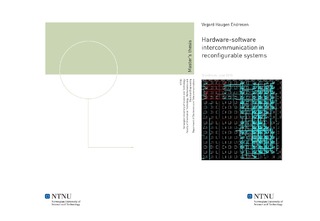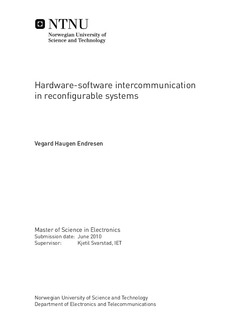| dc.contributor.advisor | Svarstad, Kjetil | nb_NO |
| dc.contributor.author | Endresen, Vegard Haugen | nb_NO |
| dc.date.accessioned | 2014-12-19T13:45:41Z | |
| dc.date.accessioned | 2015-12-22T11:44:00Z | |
| dc.date.available | 2014-12-19T13:45:41Z | |
| dc.date.available | 2015-12-22T11:44:00Z | |
| dc.date.created | 2010-09-13 | nb_NO |
| dc.date.issued | 2010 | nb_NO |
| dc.identifier | 351176 | nb_NO |
| dc.identifier | ntnudaim:5425 | |
| dc.identifier.uri | http://hdl.handle.net/11250/2369953 | |
| dc.description.abstract | In this thesis hardware-software intercommunication in a reconfigurable system has been investigated based on a framework for run time reconfiguration. The goal has been to develop a fast and flexible link between applications running on an embedded processor and reconfigurable accelerator hardware in form of a Xilinx Virtex device. As a start the link was broken down into hardware and software components based on constraints from earlier work and a general literature search. A register architecture for reconfigurable modules, a reconfigurable interface and a backend bridge linking reconfigurable hardware with the system bus were identified as the main hardware components whereas device drivers and a hardware operating system were identified as software components. These components were developed in a bottom-up approach, then deployed, tested and evaluated. Synthesis and simulation results from this thesis suggest that a hybrid register architecture, a mix of shift based and addressable register architecture might be a good solution for a reconfigurable module. Such an architecture enables a reconfigurable interface with full duplex capability with an initially small area overhead compared to a full scale RAM implementation. Although the hybrid architecture might not be very suitable for all types of reconfigurable modules it can be a nice compromise when attempting to achieve a uniform reconfigurable interface. Backend bridge solutions were developed assuming the above hybrid reconfigurable interface. Three main types were researched: a software register backend, a data cache backend and an instruction and data cache backend. Performance evaluation shows that the instruction and data cache outperforms the other two with an average acceleration ratio of roughly 5-10. Surprisingly the data cache backend performs worst of all due to latency ratios and design choices. Aside from the BRAM component required for the cache backends, resource consumption was shown to be only marginally larger than a traditional software register solution. Caching using a controller in the backend-bridge can thus provide good speedup for little cost as far as BRAM resources are not scarce. A software-to-hardware interface has been created has been created through Linux character device driver and a hardware operating system daemon. While the device drivers provide a middleware layer for hardware access the HWOS separates applications from system management through a message queue interface. Performance testing shows a large increase in delay when involving the Linux device drivers and the HWOS as compared to calls directly from the kernel. Although this is natural, the software components are very important when providing a high performance platform. As additional work specialized cell handling for reconfigurable modules has been addressed in the context of a MPEG-4 decoder. Some light has also been shed on design of reconfigurable modules in Xilinx ISE which can radically improve development time and decrease complexity compared to a Xilinx Platform Studio flow. In the process of demonstrating run time reconfigurations it was discovered that a clock signal will resist being piped through bus macros. Also broken functionality has been shown when applying run time reconfiguration to synchronous designs using the framework for self reconfiguration. | nb_NO |
| dc.language | eng | nb_NO |
| dc.publisher | Institutt for elektronikk og telekommunikasjon | nb_NO |
| dc.subject | ntnudaim | no_NO |
| dc.subject | SIE6 elektronikk | |
| dc.subject | Krets- og systemdesign | |
| dc.title | Hardware-software intercommunication in reconfigurable systems | nb_NO |
| dc.type | Master thesis | nb_NO |
| dc.source.pagenumber | 63 | nb_NO |
| dc.contributor.department | Norges teknisk-naturvitenskapelige universitet, Fakultet for informasjonsteknologi, matematikk og elektroteknikk, Institutt for elektronikk og telekommunikasjon | nb_NO |

